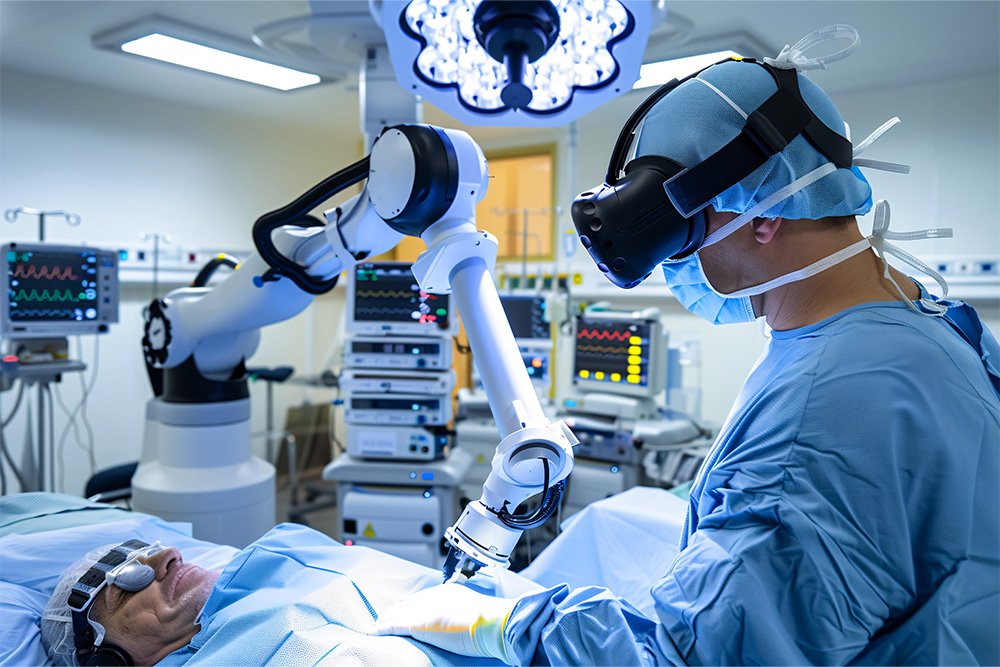Robotic Surgery
Robotic Surgery services offered in Central Midtown, New York and East Hills, NY
Robotic surgery uses tiny “keyhole” incisions to access your body, reducing pain, blood loss, and recovery time. Fellowship-trained urologist David B Samadi, MD, sees patients at his Central Midtown Manhattan office in New York City to determine if robotic surgery is the right choice. The precise instruments he uses allow him to remove the abnormal prostate gland and other tissue without harming the surrounding area. Call Dr. Samadi’s office today or book an appointment online for superior results in your sex life and urinary control after robotic surgery.

What is robotic surgery?
Robotic surgery combines state-of-the-art technology with a surgeon’s knowledge and skill to perform extraordinarily precise operations. Dr. Samadi uses the da Vinci® system — among the most advanced medical robots. This cutting-edge device improves vision and control, allowing Dr. Samadi to complete more precise movements.
Robotic techniques suit various urological procedures, including kidney and bladder surgeries. Dr. Samadi is an expert in robotic radical prostatectomy or robot-assisted laparoscopic prostatectomy (RALP) to remove the prostate gland.
Dr. Samadi operates a surgeon console during robotic surgery. This allows him to control the robotic arms performing the incisions. Dr. Samadi is highly trained in robotic prostate surgery and has completed over 7,000 successful robotic prostatectomies.
Why would I need robotic surgery?
Dr. Samadi might recommend a robotic prostatectomy to remove cancer confined to the prostate gland. It involves partially or entirely extracting prostate tissue, including the seminal vesicles that produce semen. The seminal vesicles connect to your vas deferens — tubes in the testicles that transfer sperm into your urethra when you ejaculate.
Your Gleason score (a system for grading prostate cancer) determines the need for surgery. It measures differences in cancer cells and healthy cells under a microscope. This information helps predict your risk of prostate cancer spreading. The Gleason score ranges from two (the least aggressive) to 10 (the most aggressive).
Dr. Samadi assesses your Gleason score after the lab analyzes a prostate tissue sample. He gets the sample during an MRI fusion biopsy, which Dr. Samadi performs if you have elevated prostate-specific antigen (PSA) levels in your blood.
What happens during robotic surgery?
The technique used during robotic surgery varies depending on the operation’s purpose. A robotic prostatectomy requires five small incisions of one-quarter of an inch in your lower abdomen. Dr. Samadi guides the robot arms to make the incisions and insert instruments, including a sophisticated video camera.
The camera shows Dr. Samadi 3D images magnified 10 times for unrivaled clarity. He uses these images to control the robot arms as they cut and remove the prostate gland.
Dr. Samadi developed a signature robotic surgery using his exceptional knowledge and skill. The Samadi-Modified Advanced Robotic Technique (SMART) is a revolutionary advancement in prostate cancer treatment called bloodless prostate surgery.
SMART causes far less damage to tissues, nerves, and blood vessels and doesn’t involve sutures. It substantially reduces:
- Blood loss
- Pain
- Hospital stay length
- Recovery time
- Side effects
You’ll have minor marks on your abdomen after SMART surgery but no unsightly scars.
Call David B Samadi, MD, today or book an appointment online to learn more about robotic surgery.
Contact us
Connect With
Address
485 Madison Avenue, 21st Floor, New York, NY 10022
Call Us
Address
2200 Northern Blvd Suite 120, East Hills, NY 11548